In 2012 CCHG published Walking Along Rathdowne Street, a major study of 100 years of shopping, services and stories in Rathdowne Street North Carlton.
We are now extending this study to include sites of interest south of Princes Street, and to update information as businesses change hands.
If you have old photos or stories about your experiences with particular businesses or institutions we would appreciate hearing from you.
Contact CCHG.
The Powers of Rathdowne Street
The former Power's bakery site, tucked away behind the shops in Rathdowne Street and accessed via a laneway off 145 Pigdon Street, was sold on 15 December 2023.
The build date of "circa 1870" cited in real estate advertisements is well off the mark by two decades.
The crown allotments on the south west corner of Rathdowne and Pigdon streets were first sold in 1871 and James Francis Arnold purchased allotments
23, 24, 25 and 26 in 1885. Until 1890, the allotments were recorded as vacant land in the rate books.
In that year, the future bakery site was subdivided from parts of allotments 23 and 24, and the key word "erecting" appears in the rate books.
The buildings, comprising brick and wood stables, a store and an office, were completed by 1891 and occupied by Mr Arnold himself.
He also owned the three houses at 141 to 145 Pigdon Street and the eight shops in Rathdowne Street, numbered at 921 to 935 at the time.
They are now numbered 909 to 923 Rathdowne Street.1,2
James Francis Arnold was a former Melbourne City Councillor for Victoria Ward, and Arnold Street (originally Sullivan Street) in Princes Hill was named after him.
He was married twice, to Caroline Adams in Adelaide in 1851 and Mary Ann Wheeler in 1894. In business, Arnold transitioned from selling corn to selling real estate.
He was a licensed auctioneer and real estate agent and had been buying and selling properties in Carlton since the 1860s.
However, his record keeping and investment management was not always up to scratch and he was declared insolvent twice, in 1878 and 1894.
Listed amongst the creditors in the latter case was his new wife Mary Ann, to whom he owed £500.
The Rathdowne and Pigdon Street properties were mortgaged to the Mutual Assurance Society of Victoria Limited and they foreclosed in 1894.
James Francis Arnold died in July 1908 and, at the time of his death, he owned real estate in East Brunswick and North Fitzroy valued at £1,914.
However, the debt to his wife Mary Ann had increased more than fivefold from £500 to £2,640. Arnold also had several outstanding mortgages and unpaid bills,
well in excess of his real estate value. The total value of his estate was a negative balance of £2,817, 15 shillings and 2 pence.
Mary Ann, the executrix of his estate, would not have been pleased to be lumbered with her late husband's debts.3,4,5,6,7,8
The Power family of bakers was not the first to occupy the bakery site, but they were the longest running business there.
Thomas Power, who came from Ireland, took over the existing bakery from Alexander Montgomerie in 1912.
After Thomas's death in 1925, his widow Bridget continued the business, assisted by her children.
Bridget died in 1953 and her sons Thomas, Michael and John inherited the bakery and Rathdowne Street shop. Michael (Mick) Power continued the business until 1967,
thus ending 45 years of baking. The bakery and stables were sold to an investor and, in more recent years, they have been converted into a substantial residence.9
Notes and References
1 The former bakery site is listed as 145A Pigdon Street in real estate advertisements.
However, the address is recorded as 141A Pigdon Street in the Land and Survey Spatial Information (LASSI) database and Melbourne City Council rate books.
2 Building ownership and occupancy information has been sourced from land title records and Melbourne City Council rate books for Victoria Ward.
3 South Australian Marriage Registration, 1851, p. 279, no. 8
4 Victorian Marriage Reg. No. 243/1894
5 The Herald, 14 October 1878, p. 3
6 The Age, 7 April 1894, p. 10
7 Victorian Death Reg. No. 8842/1908
8 109/238 James F Arnold: Grant of probate (VPRS 28/P0000, 109/238)
9 The Power family recollections are published in "Carlton Voices" (CCHG, 2018), p. 105-114.
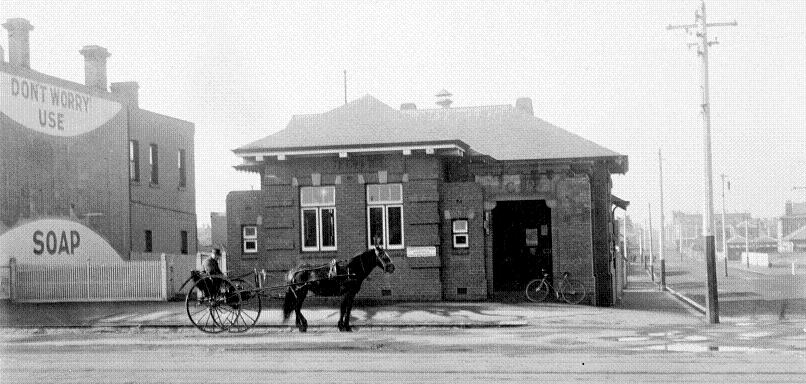
Digitised Image: State Library of Victoria
North Carlton Post Office
After nearly 100 years of delivering letters and parcels, the North Carlton Post Office in Rathdowne Street closed its doors at midday on Friday 14 October 2022,
and re-opened the following Monday at 607 Lygon Street, Princes Hill.
The large brick building at 546 Rathdowne Street, on the corner of Richardson Street, was the first purpose-built post office in North Carlton.
The vacant land was acquired by the Commonwealth Government in 1911 and plans were drawn up in 1912.
While no report of the official opening date has been located, the post office was in operation by 1913.
Over the years, the building has undergone several changes, reflecting developments in postal and telecommunication services.
In the original floor plans, the two enclosed booths either side of the main façade are designated as telephone boxes,
in the days when public telephone calls were operated-connected.
External telephone boxes were added decades later to the picket-fenced area north of the building,
and subsequently removed as the demand for public telephone access waned.
The external brickwork has been painted over and is now a cream colour.
In recent years, steps and a ramp for disabled access have been added to the front entrance.1
The need for postal and telegraph services in the rapidly-growing suburb of North Carlton was demonstrated decades before the new post office was built.
In February 1888, a deputation comprising Mr Gardiner (MLA) and Councillor Mills
called on the Postmaster General to open the Rathdowne Street telegraph station as a matter of necessity.
The first North Carlton post office premises recorded in Sands & McDougall in 1888 was a shop at 783 Rathdowne Street, near the Macpherson Street corner.
Miss Eliza White was the postmistress and she shared the premises with Mrs G. White, a stationer.
In the early days of Carlton, it was not uncommon for postal services to be operated in conjunction with other businesses, such as stationers and newsagents.
Miss and Mrs White remained at the address until 1892, when both moved to 797 Rathdowne Street, a short distance north of the Macpherson Street corner.
The next move occurred in 1896 to 428 Rathdowne Street, on the east side, and the last recorded listing was in 1913.2,3
Elsewhere in Carlton, the post office at 146 Elgin Street was built in 1883 and officially opened in April 1884.
The Carlton Post Office was closed in 2021 and postal operations were moved to the retail area in Lygon Court.
The South Carlton Post Office, at 113-119 Lygon Street,
was officially opened in April 1964 and is the only purpose built post office remaining in Carlton.4,5,6
Notes and references:
1 Digitised plans and historic photos of the North Carlton Post Office building are available on the National Archives of Australia website.
2 The Argus, 2 February 1888, p. 11
3 Building occupancy information has been sourced from Sands & McDougall directories and Melbourne City Council rate books.
4 The Age, 28 July 1883, p. 6
5 The Age, 2 April 1884, p. 5
6 The Sun, 18 April 1964, p. 2
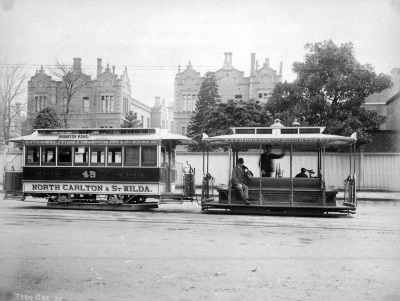
Digital Image: State Library of Victoria
Dummy Car (right) and Trailer in Lonsdale Street Melbourne
Heading to North Carlton via Lygon, Elgin and Rathdowne Streets
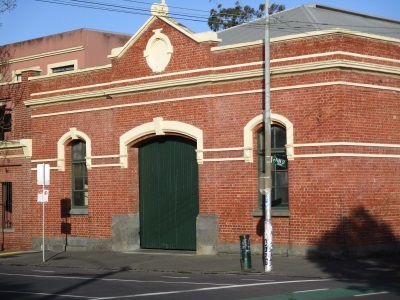
Photo: CCHG
Former Cable Tram Engine House
Corner of Rathdowne and Park Streets North Carlton
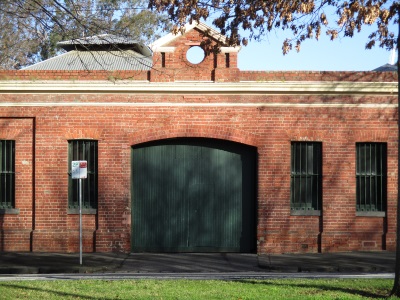
Photo: CCHG
Former Cable Tram Shed
Rathdowne Street North Carlton
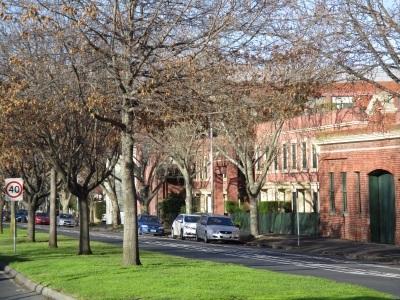
Photo: CCHG
Median Strip in Rathdowne Street North Carlton
Site of Former North Carlton Cable Tram Line
Notes and References:
1 John Keating. Mind the Curve. Transit Australia Publishing, Rev. ed., 1972
2 The Age, 27 July 1886, p. 6
3 The Carlton cable tram line (also known as Johnston Street Bridge) travelled via Lygon, Elgin and Johnston Streets and terminated at Abbotsford.
The North Carlton linee followed the Carlton line to Rathdowne Street, then travelled north to Park Street.
Lygon Street north of Elgin Street was not part of the cable tram network.
4 Mind the Curve, op cit
5 The Argus, 11 December 1886, p. 11
6 The Age, 24 December 1886, p. 7
7 The engine house for the Carlton line was near the corner of Johnston and Brunswick Streets, Fitzroy and for the Nicholson Street line on the corner of Nicholson and Gertrude Streets, Fitzroy.
8 Victorian Heritage Database Report, Register No: H0718
9 The Age, 2 March 1896, p. 6
10 The Australasian, 18 January 1980, p. 37
11 The Age, 2 July 1930, p. 13
12 Yarra Trams Website
13 The Argus, 3 August 1936, p. 8
14 Gippsland Times, 8 February 1937, p. 3
15 The Age, 24 February 1937, p. 12
16 Certificate of Title, Volume 6514, Folio 1302664
17 Victorian Heritage Database Report op cit
|
The Cable Trams of Rathdowne Street
Bus services now run the full length of Rathdowne Street, from Victoria Street, Carlton, through to Park Street, North Carlton.
From 1889 to 1936, Rathdowne Street had its own cable tram service between Elgin and Park Streets, but its introduction was not without controversy and North Carlton nearly missed out on this modern form of transport.
Cable trams were a wonder of 19th century transport technology, designed on the simple principle of a tramcar on tracks pulled by a continuous cable.
The tramcar comprised a leading "dummy" car and one or more trailers for carrying passengers.
The driver or "gripman" controlled the movement of the dummy car by gripping or releasing the cable that ran in a slot between the tram tracks, just below the surface of the road.
The other member of the crew, the conductor, moved between the trailer and dummy car to collect fares from passengers and had the important job of signalling to the gripman when it was safe to move after letting passengers on or off. 1
Melbournians embraced the new transport technology.
The first cable tram service to Richmond commenced in November 1885 and by July 1886 The Age reported "The tramway system of Melbourne, now clasping the city and its environs like the tentacles of an octopus, is making far more rapid progress than was even hoped for or expected."
Carlton residents enjoyed the benefits of cable tram services along Nicholson Street to Park Street, and Carlton via Lygon and Elgin Streets, introduced on 30 August and 21 December 1887 respectively.
Plans were also in place for a North Carlton branch line, turning off the Carlton line at Elgin Street and travelling north along Rathdowne Street. 2,3
While cable trams were simple in principle, they required extensive, and expensive, infrastructure to operate - a steam-driven cable winding engine, an engine house, tram sheds and miles of tram tracks and multi-strand steel cables.
Horse-drawn trams and omnibuses were a cheaper alternative by direct cost comparison, but they had a lower passenger-carrying capacity and additional costs associated with the care and stabling of horses - not to mention pollution caused by horse dung.
Tram infrastructure was under the control of the Melbourne Tramways Trust, who built and maintained the tracks, while the Melbourne Tramway & Omnibus Company was responsible for operating the service.
As in any business partnership, there were sometimes differences of opinion and this came to the fore during planning for the North Carlton line. 4
In December 1886, the Melbourne Tramway & Omnibus Company wrote to the Melbourne Tramways Trust expressing concerns about the cost of constructing an engine house for the North Carlton line.
The Melbourne Tramway & Omnibus Company favoured a horse tramway, stating that the estimated cost of £20,000 for a cable tram service was not justified for such a short route and would not be economically viable.
The horse tramway proposal received support from the Melbourne Tramways Trust, with Councillor Cullen adding that there was no scope for extending the line beyond Park Street, which ended in a quarry hole.
Councillor Ievers, representing the interests of North Carlton, mounted a strong case for a cable tram service as a superior form of locomotion.
The matter was referred to back the works committee and debated at length.
In the end, Councillor Ievers triumphed and the horse tramway proposal was defeated.
5,6
The engine house was built on the south west corner of Rathdowne and Park Streets, an unusual choice of location as other engine houses in the network were placed midway along the cable tram line.
The building was designed by Melbourne Tramways Trust architect Robert Gordon and constructed of brick on a bluestone
base and decorated with cement plaster mouldings, cornices and architraves.
By comparison with its Nicholson Street counterpart, the Rathdowne Street engine house was less decorative and, given the cost controversy, perhaps the Melbourne Tramways Trust chose to represent function and economy in the design.
The adjacent tram shed was designed by architect Frederick Williams and built by Robert Fraser of Parkville.
The North Carlton cable tram service opened on 9 February 1889 and a year later was connected to the St Kilda line.
The residents of North Carlton enjoyed the same modern service as their Carlton counterparts and the cable tram service was credited with fostering development of the business and retail sector in Rathdowne Street. 7,8
Rathdowne Street had its long-awaited tram service, but things did not always run smoothly.
The turning at the corner of Rathdowne and Elgin Streets was sometimes tricky, and passengers who failed to heed the gripman's warning to hold on and "mind the curve!" might find themselves flung out onto the road.
Pedestrians were also at risk negotiating this corner.
In March 1896, a 5 year old boy tripped while crossing the tram tracks and was run over by the dummy car of a cable tram turning into Elgin Street.
Dr Cole was called from his surgery nearby in Rathdowne Street, but nothing could be done for the young boy, who suffered extensive head injuries.
Children were, unfortunately, often casualties of tram accidents.
In January 1908, a toddler was killed when she ran between the dummy car and trailer of a tram in Rathdowne Street.
Her mother had sent her across the road on a message and, in the present era of "helicopter parenting", it beggars belief why a parent would allow a toddler to cross the road unsupervised.
But attitudes to child supervision were different a century ago, when children often played in the streets, and the young girl may have regarded the cable tram as a big toy for her entertainment. 9,10
Cable trams, though large and sturdy transport vehicles, were occasional victims of accidents.
In June 1930, a dummy car was derailed following a collision with a motor truck travelling on the wrong side of Rathdowne Street.
The truck driver claimed he was making a right hand turn from Newry Street when the front wheels of the truck locked and he lost control of the vehicle, causing it to veer into the path of the oncoming tram.
Neither tram nor truck could stop in time to avoid the collision, which forced the four wheels of the dummy car off the rails.
The truck driver, William Francis McDonnell was charged with "having on 2nd June driven a motor truck in Rathdown-street on the wrong side of the road without justifiable cause."
He was fined £3, with 15 shillings costs, a month later in Carlton Court.
The fine was for the traffic offence only and did not reflect the cost involved in repairing the dummy car and getting it back on the rails.
Both the truck driver and the tram gripman, Clarence Henry Turner, were local residents living in Station Street, North Carlton. 11
Cable trams had their heyday in the 19th century, but lasted only a few decades into the 20th century.
The Melbourne and Metropolitan Tramways Board was established in November 1919 as the sole responsible authority for tram infrastructure and services.
In the same year, the steam-driven cable winding engine at North Carlton was replaced by an electric-powered engine.
Electrification was seen as the new technology and the way of the future, promising a more efficient service and better carrying capacity.
Lygon Street was already ahead of the pack with an electric tram service, dating back to 1916, north of Elgin Street.
North Carlton, the last of the cable tram lines servicing Carlton to open, was the first to close.
On its final journey on 2 August 1936, both the tram car and crew were besieged by souvenir hunters, seeking a piece of memorabilia.
The Carlton line closed in April 1939 and Melbourne's last cable tram ride was from Bourke Street via Nicholson Street to Northcote in October 1940.
The Carlton, North Carlton and Nicholson Street cable tram lines were replaced with motor buses and therefore missed out on the benefits of electric trams.
Services via Nicholson Street to East Brunswick were later restored with electric trams in 1956. 12,13
The closure of the North Carlton cable tram line left a open space in the middle of Rathdowne Street and this proved to be the scene of yet another controversy in 1937.
The Melbourne City Council proposed a plantation in the centre of Rathdowne Street, as part of a tree planting scheme to commemorate the coronation of King George VI.
The Council's ambitious scheme to plant a total of 5,000 trees within the municipality, at a cost of £20,000 over several years, met with strong resistance from the ratepayers of Victoria Ward.
A door-to-door survey of shops and businesses in Rathdowne Street revealed 87 against and only 3 in favour of the proposed plantation.
Anti-tree sentiment was running high, with some residents stating they would cut down any trees planted.
The main objections were that a tree plantation would detract from the commercial appearance and character of the street, and would be a hindrance to vehicular traffic, which had increased since motor buses replaced the old cable trams.
Business interests and traffic ruled in 1937 and the plantation proposal, like the horse tramway proposal decades before, was defeated. 14,15
Rathdowne Street had to wait another four decades for its plantation, implemented in almost opposite circumstances. The controversial eastern freeway opened in 1977, amidst protests from Council, local businesses and residents alike.
Rathdowne Street had become a feeder road for the freeway, via Princes Street, and Council proposed a median strip to slow down traffic and improve local amenity. This proposal was successful and, decades later, the median strip of mature trees contributes to Rathdowne Street's unique character and continues to be an asset, rather than a hindrance, to local businesses and residents.
The engine house and cable tram shed still stand on the corner of Rathdowne and Park Streets and are now converted to residential apartments.
Most of the land bounded by Rathdowne, Park and Mary Streets was acquired by the E.M.F. Electric Company in 1940, and the former tram buildings were used for industrial purposes until the 1990s.
According to a report on the Victorian Heritage Database, there is possible evidence of tracks, pits and a turntable surviving under the concrete floor.
If the buildings are ever demolished, or the concrete floor is dug up, remnants of significant 19th century transport infrastructure could be revealed. 16,17
|
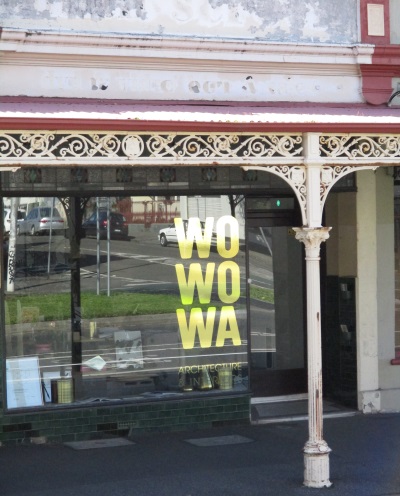
Photo: CCHG
420 Rathdowne Street North Carlton
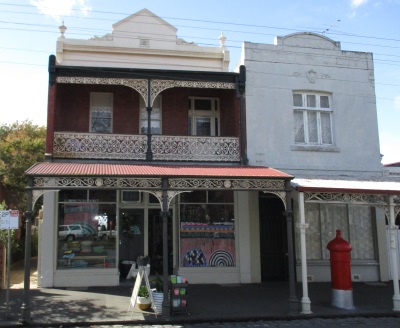
Photo: CCHG
430 Rathdowne Street North Carlton
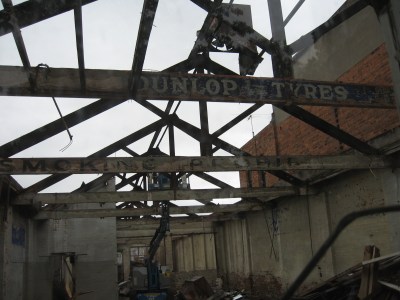
Photo: CCHG
Signage uncovered during demolition of Martin Shelley's former garage at 520-522 Rathdowne Street
Notes and References:
1 Biographical information has been sourced from birth, death and marriage records.
2 Divorce case file 1911/241 (VPRS 283)
3 Record (Emerald Hill), 4 January 1896, p. 2
4 Building ownership and occupancy information has been sourced from land title records, Council rate books and Sands and McDougall directories.
5 Divorce case file 1911/241 op cit
6 The Prahran Telegraph, 3 October 1914, p. 6.
7 Prahran Chronicle, 16 June 1917, p. 5
8 Building application file and plans no. 2962 (VPRS 11200 and 11201)
9 City of Melbourne, Town Clerk's correspondence files, 1940-41 (VPRS 3183)
10 Melbourne General Cemetery and Fawkner Memorial Park cemetery records
11 Register of Demolitions, D3433 (VPRS 17292/P1/001)
12 BA 11259 (Melbourne Building Application Index)
|
The Mechanic of Rathdowne Street
Martin John Shelley
As a motor mechanic, Martin Shelley knew all there was to know about cars.
He started as a cycle manufacturer in Rathdowne Street, North Carlton, and made the successful transition to servicing motor cars when four-wheeled motor transport overtook leg-powered two-wheeled transport.
As a motor car driver, however, Martin did not always know or obey the road rules and this caused him to ran foul of the law on several occasions.
Martin John Shelley was born in Albert Park on 4 July 1883 (or 1882, as stated in his divorce petition), the first son of Martin John Shelley and Mary Jane Mahon.
His parents were married in 1882 and they had four other children - Bernard, Maria, Agnes and Elizabeth - born between 1885 and 1895.
When Martin was a teenager, his parents' martital discord became public when his mother took legal action against his father.
At South Melbourne Court in December 1895, Mary Jane Shelley declared herself to be "in dread of murder at the hands of her husband,
who, she averred, had beaten and threatened to kill her".
Her husband countered her accusation by claiming that his wife was "a terror for carrying on" with young men "right before me".
When he threatened to "give her a hiding", the young men in question "gave me a hiding".
The Court ruling reflected a fairly lenient attitude toward domestic violence at the time and Martin Shelley was bound in two sureties of £10 each to keep the peace for six months.
1,2,3
The younger Martin Shelley lived in North Carlton from about 1899 onwards, initially at 485 Nicholson Street and later at several addresses in Rathdowne Street.
He married a local woman, Annie Keenan of Amess Street, on 19 February 1903 at Holt's Matrimonial Agency in Queen Street, Melbourne.
Their first child was born at Royal Women's Hospital, Carlton, in 1904 and he was named Martin John Shelley, after his father and grandfather.
He died in the same year and a second child, also named Martin John Shelley, was born at 420 Rathdowne Street, North Carlton, on 21 January 1905.
By this time, Martin Shelley had an established cycle business and he moved to larger premises he purchased at 430 Rathdowne Street a few years later in 1909.
4
In March 1911, Martin embarked on an extended overseas trip to England via America, described by him as "partly of pleasure and partly in the interests of my business as a cycle manufacturer".
Annie had helped out in the business, in addition to her family and household duties, and Martin was confident of her ability to manage operations during his absence.
On his return some seven months later in October 1911, he discovered that his wife was "carrying on" with another man, A.G. Burton, and they were living together as man and wife in Sydney.
Not only had she taken their son, Martin Jnr, with them, Annie had also cleared out the bank account that her husband had set up to enable her to run the business.
Martin travelled to Sydney and found that his son was enrolled at a local school under the name "Martin John Burton".
He brought the boy back home to North Carlton, and sought a dissolution of his marriage on the ground of misconduct.
Once again, the Shelley family's marital discord was made public, this time in the Supreme Court of Victoria in May 1912.
Neither the respondent, Annie Shelley, nor the co-respondent, A.G. Burton, appeared in court and a decree nisi was granted, with costs awarded against the co-respondent.
5
Martin had a run-in with the police in October 1914, soon after the outbreak of World War 1.
He was charged with driving on the wrong side of the road in St Kilda and, in his defence, he claimed that he had a soldier in the car.
Did Martin consider that his act of transporting a soldier in support of the war effort somehow over-rode the law of the land?
He was fined 10 shillings for this incident.
Martin used a similar "soldier in the car" defence a few years later in a spectacular police chase from South Yarra to North Carlton in May 1917.
He had been involved in a minor traffic accident, but he refused to give his name and address to the police, as required by law.
The car took off at speed, with a soldier and a civil servant in the back seat, and the police constable clinging on for dear life.
When Martin arrived back in North Carlton, he remonstrated with the police constable and threated to sue him because he had implied that he was drunk.
The case was heard in Prahran Court in June 1917 and Martin was let off the car accident charge, then faced the charged of failing to give his name and address.
He pleaded guilty under provocation, claiming he was "not conversant with the law", and was fined £7 and 10 shillings, with 1 shilling costs.
The court noted that Shelley had two prior convictions for driving at excessive speeds.
One of his passengers, Richie Lindsay Connard, was found guilty of "having obstructed Constable Rice in the execution of his duty" and was fined £1.
6,7
A few months before the police chase, Martin Shelley had a daughter, Dorothy Ivy, born to Ivy Rose Wells on 6 March 1917.
They went on to have four other children and they were finally married in 1922.
With a growing family and demand for larger business premises, Martin purchased a double block of land further north in 1920.
The new garage was purpose built at 520-522 Rathdowne Street in 1921 and had the advantage of rear access via a laneway off Richardson Street.
The Shelley family remained living at 430 Rathdowne Street until 1936, when Ivy bought a house at 823 Rathdowne Street, directly across the road from Martin's garage.
This substantial six roomed house was to be the final home of Martin and Ivy Shelley.
By the 1940s, Martin was ready for retirement.
The garage building at 520-522 Rathdowne Street was converted for use as a drycleaner, with the addition of a shopfront, in 1940/41 and sold to Pullars Dry Cleaners Pty Ltd in 1951.
Council correspondence indicates that there were issues with the change of business and location of above-ground tanks for storing volatile liquids (ie: white spirit) in a residential area.
8,9
Ivy Rose Shelley died on 9 September 1963, aged 68 years, and her husband Martin John Shelley died nine months later on 17 June 1964, just short of his 81st birthday.
Their ashes are buried side by side in a rose garden at Fawkner Memorial Park. Rose's dedication reads "The rose still grows beyond the wall".
Martin's son by his first marriage, Martin John Shelley Jnr, died on 19 October 1971, aged 66 years.
His half-sister Dorothy Ivy Moss (neé Shelley) lived to the ripe old age of 95 years and died on 12 May 2012.
Both siblings are buried at Fawkner Memorial Park.
Three of the five buildings in North Carlton occupied by Martin Shelley still exist – 485 Nicholson Street,
420 Rathdowne Street and 430 Rathdowne Street (now Caffe Assist).
The house at 823 Rathdowne Street was demolished in 1972 and replaced by a new block of flats in 1973.
Martin Shelley's former garage continued as a drycleaning business, initially as Pullars and later as Mode Drycleaners, until 2011.
The building was demolished in late 2013 and redeveloped as residential apartments.
10,11
Related items:
Constable and motorist - unwilling joy rider
Development update
|
The Barbers of Rathdowne Street
The barber shop in Rathdowne Street, at no. 795 near Macpherson Street, is something of a surprise in an age when unisex hairdressers are commonplace,
but for most of the twentieth century barbers well outnumbered women's hairdressers.
Israel Halperin opened his barber shop in 1931 at 386 Rathdowne Street, today the home of Gerald's Bar.
Polish born, he had migrated first to Palestine before arriving in Australia in 1927.
At this time there was a very substantial Jewish population in North Carlton and Princes Hill, many of them Yiddish speakers from eastern Europe,
and their numbers continued to grow in the years immediately before and after World War 2.
Halperin must have felt very comfortable in this location with Glickman's bakery, Wolf Gotlib the grocer and Polonsky Bros. kosher butchers all close by.
In fact his barber shop soon became a de facto Yiddish speaking social club.
Many people who were children at the time mention him in their recollections.
In the 1950s he used to give children free chewing gum and one of the barber's seats was fitted with a child's car to make it more attractive to his younger customers.
Arnold Zable in his novel Scraps of Heaven vividly recreates the Rathdowne Street of those years.
For many of the Jewish residents at this time Carlton was a temporary stopping place and by the 1960s most were moving south of the river to St Kilda or Caulfield.
After 30 years in North Carlton Israel Halperin did the same.
In 1962 his business was taken over by an Italian barber, very appropriately as Italian migrants were moving into the area in large numbers, and Halperin lived in Caulfield until his death in 1976.
Still today those with very good eyesight can make out the faint traces of stripes simulating a barber's pole on the wall just to the north of Gerald's Bar.1
In the next block north, just across Fenwick Street, there was a very different barber.
Before the wave of Jewish immigrants in the 1930s and 1940s, it was common in working class Carlton for people to live and work in one place for most of their lives.
One such is Walter Large who had a business in Rathdowne Street for more than 50 years.
When Halperin arrived, Large had already been trading there for thirty years.
Born in Tasmania in 1876, he married in Melbourne in 1901 and immediately took over an existing hairdressing and tobacconist business at 412 Rathdowne Street, next to the present-day newsagent.
He and his wife Frances lived above the shop and sons Ernest and Leslie were born in 1902 and 1905.
Apparently the business was doing well because in 1924 they moved to no. 997, a terrace house at the northern end of the street, and the business was transferred to no. 422, a single storey shop just north of Fenwick Street, today an optometrist's.
It continued until 1952 and the shop was still a hairdresser's in 1975.
Walter's last home before his death in 1958 at the age of 80 was on the corner of Station Street and Park Street.
His son Ernest had a hairdressing business in Albert Park from 1934 for more than thirty years.
Walter Large's story is echoed by that of a third barber with a long history in Rathdowne Street, James John Hogan, born in Fitzroy in 1886.
He had his first hairdressing business on the corner of Macpherson Street (no. 480) in 1910 when he would have been 24.
He moved twice, finally settling at no. 516, south of Richardson Street, in 1922.
He lived and worked at that address until 1964 and stayed there alone, never having married, until his death in 1967.
It would have been very convenient for him.
His property backed onto the same lane as that of his twin brother, John James Hogan, who lived at 95 Amess Street, a two-second commute if he wanted some company.
1 Zable, Arnold. Scraps of Heaven. Text Publishing, 2004
Related item:
From Tobacconist to Tea Shop
And Then There Was One
Rathdowne Street Chemists
Today David Nolte's pharmacy in the heart of Rathdowne village is the only one in this stretch of Rathdowne Street, but for most of the past century this was not the case.
As early as 1884 there was a chemist, Johnston, on the south eastern corner of Lee Street, a small shop which remained a pharmacy for ninety years.
It was vacant for a period in 1933 and for 12 years after that it was run in turn by two women, perhaps indicating a less than thriving concern.
But many locals remember Vince, pharmacist from 1947 to 1969.
When someone became ill in the middle of the night, knocking on his side door in Lee Street was a tempting alternative to finding a doctor.
After Johnston on the Lee Street corner, the next chemist opened in 1889 on the south western corner of Curtain Street, until recently Café Bagatelles.
Strover took over the business in 1891 and traded there until 1912, when he moved a little further south into no. 671, a purpose built shop as can be seen from the decorative glass over the doorway.
Until 1939 Strover and two successors lived in the terrace house at no. 669 next door to the shop. That pharmacy closed in 1957.
In 1913 a third chemist opened in Victoria House, no. 536 Rathdowne Street, on the south eastern corner of Richardson Street.
This shop is relatively isolated and previously had a mixed trading history, but as a chemist's it was successful and continued on that site until 1987.
The names of two of the early proprietors can still be seen on signage at the back of the building.
One reason for this success in an unpromising location may be that from 1932 to 1970 Doctor Moses Sternfeld, remembered in Jewish memoirs for making his house calls on foot, had his consulting rooms directly opposite at no. 841 Rathdowne Street (which today is again a medical centre).
Similarly between 1890 and 1935, there was always a doctor practising in one of the terrace houses in the same block as the pharmacy at no. 671.
Paul Van Prooyen, the last chemist in the shop on the Lee Street corner, took over in 1970 then moved in the late 1970s to bigger premises on the other side of the street, right next door to what is now the Paragon.
In 1979 David Nolte took over the pharmacy at no. 536 from Sol Benporath, who had run it for ten years.
Within a year Paul Van Prooyen asked David Nolte to buy him out and for a while he ran the two pharmacies then consolidated them at no. 536.
Rathdowne Street now had only one pharmacy and the location could not be described as central.
The inevitable happened in 1987 when Nolte's business moved to its present location in what had been the old bike shop opposite the Kent Hotel.
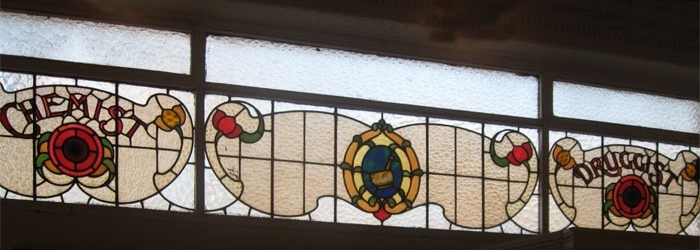
Photo: Julie Elder
Old chemist shop window, 671 Rathdowne Street, North Carlton
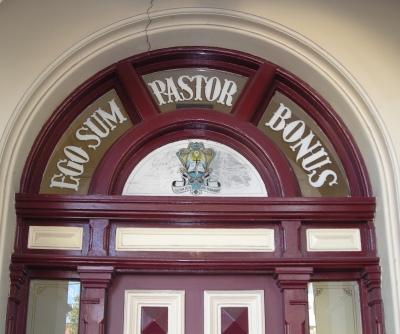
Photo: CCHG
Ego Sum Pastor Bonus - I am the Good Shepherd
88 Rathdowne Street Carlton
References:
1 Building occupancy information sourced from Sands & McDougall, 1890-1974
2 Australian Architectural Index
3 Notice of Intent, Reg. no. 3651, 22 October 1888
4 Australian Dictionary of Biography online
5 Death Index Victoria, 1921-1985
6 Davine, Annamaria. Building community : fifty years of the Pastorelle Sisters in Australia. Italian Australian Institute, La Trobe University, 2008
|
88 Rathdowne Street Carlton
The opening of the Carlton Family Medical clinic at no. 88 Rathdowne Street Carlton in May 2012 continues a long history of medical practice and service to the community.
The ten room building, which occupies the entire Rathdowne Street frontage between Macarthur Place North and Elgin Street, was designed by Wight & Lucas and built in 1888-89 on the site of Carson's former wood yard.
The original owner, Dr Frank Hobill Cole, was born in Carlton in 1863 and educated at Scotch College, East Melbourne.
He was qualified in both pharmacy and medicine, graduating from the School of Pharmacy in 1884, and the University of Melbourne with M.B., Ch.B. in 1887.
He began his medical career at the Melbourne Hospital for Sick Children, located in Pelham Street Carlton, and continued a life-long interest in paediatrics.1,2,3
Dr Cole commenced private practice at no. 76 Rathdowne Street (re-numbered 88) in 1890, and later at Lister House in Collins Street Melbourne.
In 1921, Dr Alan Bothwell McCutcheon, one of Cole's former students, joined the practice at 88 Rathdowne Street.
Dr McCutcheon's most famous house call would have been to Barkly Terrace, Carlton, where he attended the shooting scene of Squizzy Taylor, Snowy Cutmore and Snowy's mother Bridget Delia Cutmore in 1927.
Dr Cole retired in the early 1920s and died in Mornington in 1934, aged 71.
Dr McCutcheon continued to practice at no. 88 Rathdowne Street until 1959, thus ending 69 years of continuous medical service at the site.
He died in 1962, aged 75.4,5
From 1959-60 to 1963, the building was occupied by the Pastorelle Sisters, an order of Italian nuns who arrived in Australia in 1955 to assist migrants and newly-arrived proxy brides.
The Sisters operated a girls' hostel at no. 197 Drummond Street Carlton for a few years, then moved to the larger premises in Rathdowne Street.
The Order is remembered in the wording Ego Sum Pastor Bonus – I am the Good Shepherd – that appears in the glass above the front door.6
In the 1960s and 1970s, the building was converted to flats and housed multiple occupants.
But no. 88 Rathdowne Street has since returned to its medical roots as a general medical practice.
|
Walter Renny and Royal Blue Terrace
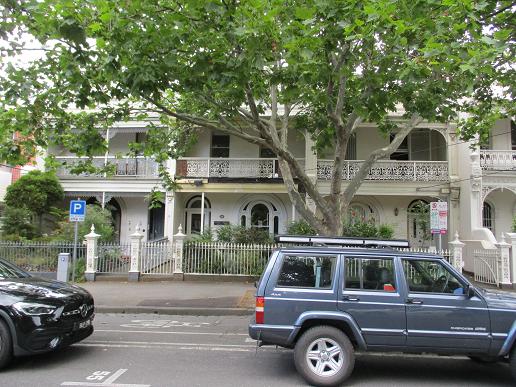
Image: CCHG
Royal Blue Terrace
233 to 237 Rathdowne Street Carlton
The colour blue is found everywhere in nature – the sea and sky, mountains in the distance, plants and flowers –
and is often associated with royalty, aristocracy and the flags of nations.
Blue was of special significance to Walter Renny, a colourful character and the original owner of Royal Blue Terrace in Rathdowne Street, Carlton.
Walter Renny, a master painter and decorator, was born in England and migrated to the Colony of New South Wales in 1853.
He settled in Sydney and married Mary Ann White at Balmain in 1857.
Renny established a business in Pitt Street, Sydney, and advertised his calling by decorating his premises with blocks of blue and white.
The building became known as the "Royal Blue House" and earned its master the nickname of "Royal Blue Renny".
Walter Renny was also active in local government, serving as alderman for the City of Sydney from December 1863 to November 1865, and December 1866 to 30 November 1870.
Renny was elected Lord Mayor of Sydney in 1869-70. He stood for the Legislative Assembly in a by-election for the seat of East Sydney in 1867,
but his bid was unsuccessful.
Preliminary advertisements for the sale of his residence "Strathfieldsaye" first appeared in Sydney newspapers in December 1871,
stating that Walter Renny was leaving the colony for health reasons.
His final departure from Sydney was announced two years later in Sydney Punch in December 1873.1,2,3
Walter Renny moved south to Melbourne and purchased land in Rathdowne Street, in a prime location opposite the Carlton Gardens, in 1874.
The land was originally part of a government grant to the Erskine Church, on the corner of Rathdowne and Grattan streets,
and was subdivided for sale under the provisions of the State Aid to Religion Abolition Act (391/1871).
An invitation for tenders for the erection of a terrace for Walter Renny was advertised in The Argus in April 1874.
The contract was awarded to James Lever, who built the three adjoining double storey houses, designed by Crouch & Wilson.
In keeping with Walter Renny's colour theme, the terrace was named "Royal Blue Terrace".
Renny and his wife Mary Ann took up residence in the first house in the terrace (now no. 233 Rathdowne Street)
and the remaining two houses (nos. 235 and 237) were rented out.
In October 1875 the Renny residence was the scene of an audacious daylight robbery, in which household and personal items valued at over £200 were stolen.
There was nobody at home on the afternoon of 5 October and the thief or thieves gained entry, police believed, with a skeleton key.
The haul, as detailed in the Victoria Police Gazette, included a small six-barrelled revolver, a silver tea service and a silver cigar case,
both engraved and presented to Walter Renny when he lived in Sydney.
In a surprising turn of events, a large sack containing some of the lesser-value stolen items was found a week later in the backyard of a house in Eastern Hill.
The following year, in July 1876, Walter Renny was appointed Justice of the Peace for the Central Bailiwick of Victoria.4,5,6,7,8
In April 1878 Walter Renny embarked on an overseas trip and, as fate would have it, he would never return to Australia.
After spending time in Italy, he became ill in Paris and, as his condition worsened, he was transferred to his mother's residence at Forest Gate in London.
He died there on 24 June 1878, aged 49 years. The reported cause of death was "congestion of the lungs",
though The Gundagai Times stated he had contracted typhus fever.
While Walter Renny died in England, he owned real estate and personal property in Australia and his estate was subject to local probate.
The houses of Royal Blue Terrace were valued at £3,000, and probate was granted to Richard Thomas Hills and Harry Ward.
Ownership changed several times over the next seventy years, when Royal Blue Terrace was subdivided and the three houses were sold separately in the late 1940s.
Royal Blue Terrace and its neighbour "Loch-Shin House" at 239 Rathdowne Street are now the only surviving 1870s buildings
in the block between Pelham and Grattan streets. The original 1860s Erskine Church, on the Grattan Street corner, was rebuilt in the 1870s, then demolished in 1971.
State School 2605, now Carlton Gardens Primary School, was opened in 1884, and the Sacred Heart Church, on the Pelham Street corner, was built from 1897 to 1899.
Walter Renny's legacy of Royal Blue Terrace is now well into its second century.9,10,11,12,13,14,15,16
Notes and References:
1 McCormack, Terri. Renny, Walter. Dictionary of Sydney, 2012
2 Sydney Morning Herald, 25 December 1871, p. 7
3 Sydney Punch, 12 December 1873, p. 3
4 Certificate of Title, volume 699, folio 636
5 Australian Architectural Index, record nos. 27272 and 77950
6 Victoria Police Gazette, 5 October 1875
7 The Herald, 13 October 1875, p. 2
8 Victoria Government Gazette, 48, 14 July 1876, p. 281
9 The Argus, 13 August 1878, p. 1
10 The Gundagai Times, 30 August 1878, p. 4
11 18/062 Walter Renny: Grant of probate (VPRS 28/P0000, 18/062)
12 Certificate of Title, volume 3427, folio 367
13 Erskine Presbyterian Church, Centenary 1850-1950
14 Demolition Permit D3373, 20 September 1971 (VPRS 17292)
15 Victorian Heritage Register H1624
16 Victorian Heritage Register H0016
From the Shores of Loch Shin
The MacDonalds of Rathdowne Street
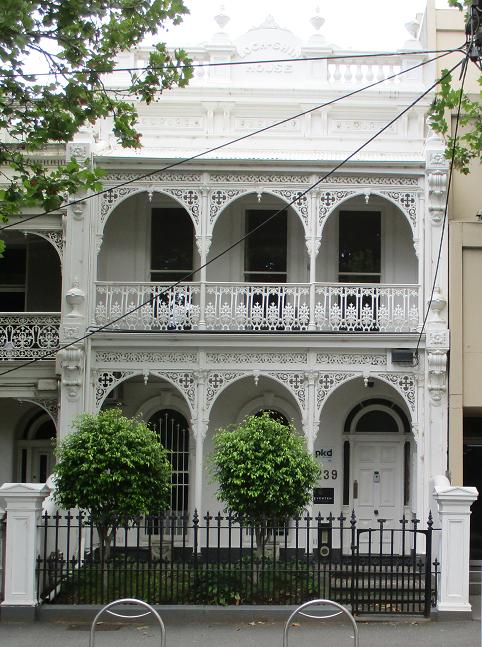
Loch Shin House
239 Rathdowne Street Carlton
The village of Lairg lies on the southern shores of Loch Shin, in the highlands of Scotland, and is a popular destination for tourists and visitors.
In September 1844 a baby boy named William Macdonald was born there and, decades later, his Scottish heritage was commemorated in the name of "Loch Shin House"
in Rathdowne Street, Carlton. William, the son of Donald and Mary MacDonald, arrived in Australia via the Aberdeen sailing ship "William Duthie" in 1865.
Four years later, in 1869, he married Margaret Mary O'Brien, daughter of Irish solicitor Thomas O'Brien.
They had a daughter, Charlotte (known as "Lotte"), born in 1870.1
The inner city suburb of Carlton was developing rapidly in the 1870s and
the State Aid to Religion Abolition Act (391/1871) enabled established churches to raise revenue from the sale of pre-existing crown land grants.
One such church was the Erskine Church, on the corner of Rathdowne and Grattan streets,
and proceeds of the land sale funded the new church building on the corner site.
The early land buyers were Sarah Hughes, Walter Renny and Bessie Stone.
Mrs Hughes and Mr Renny had houses built for themselves, while Miss Stone onsold her block of land to Margaret MacDonald in 1879.
In April of that year, a Notice of intent was lodged with Melbourne City Council for a two storey house, to be built by James Moore of Fitzroy.
The house and land was owned by Margaret, but William MacDonald was registered as the occupier and ratepayer in council rate books,
and the main householder in postal directories.
When it came to naming rights for the house Margaret, of Irish ancestry, seems to have deferred to her husband's Scottish roots.2,3
Loch Shin House, now numbered 239 Rathdowne Street, was conveniently located close to the city and directly opposite the Carlton Gardens.
Young Charlotte MacDonald was educated by the Sisters of Mercy in Nicholson Street, Fitzroy, a short walk across the Gardens.
Decades later, her name was commemorated in the "Lottie MacDonald Prize", to be awarded annually for proficiency in Christian doctrine and catechism at the school.
In the 1890s, Loch Shin House was advertised as a rental property and occupied by various tenants.
The MacDonald family moved to "Saint Duthus" in Murray Road, Preston, then back to Loch Shin House in the early 1900s.
William MacDonald worked at the Crown Law Department of Victoria for forty years and
spent the last seven years of his employment as Registrar of Probates of the Supreme Court of Victoria.
He was appointed Justice of the Peace in January 1910.4,5,6,7,8
In the meantime, Margaret was adding to her real estate portfolio. She must have been a woman of independent means,
but she was referred to as a "married woman" or "wife of William MacDonald" in land title records.
She already owned Loch Shin House and the land in Preston, and purchased several city properties in Elizabeth, Little Bourke and Lonsdale streets.
In 1912 the residence of Allan McLean, former Victorian Premier (1899-1900) and Deputy Prime Minister (1905) was on the market.
It was built in 1900 and named "Duart" after Duart Castle on the Scottish Isle of Mull.
Margaret bought the house in Beaconsfield Parade, Albert Park, and Duart was to become the final home of the MacDonald family.
Apart from the Scottish name connection, the two houses were vastly different.
Duart was a stand-alone villa, built on land three times the size of the Loch Shin House block.
While Loch Shin House looked out onto the Carlton Gardens, Duart offered bayside views and bracing sea air.9,10
Margaret Mary MacDonald died at Duart on 16 January 1916 and probate was granted jointly to her husband William and daughter Charlotte.
In her will, dated 5 October 1911, she made provision for legacies to various religious, educational and charitable institutions,
including the Church of the Sacred Heart in Rathdowne Street, Carlton, and the Sisters of Mercy in Nicholson Street, Fitzroy.
Her husband William MacDonald died seven years later, on 28 March 1923, at a private hospital in Carlton.
As a former Registrar of Probates, he was well versed in the wording of will and probate documents.
In his own will, dated 21 February 1919, he gave biographical information in the wording of his memorial – a boon to later researchers –
and detailed instructions on steps to be taken if his daughter Charlotte pre-deceased him, or if they died simultaneously.
His legacies included the "Lottie MacDonald Prize", in recognition of his daughter's education by the Sisters of Mercy in Fitzroy.11,12
William's real estate holdings – which he inherited from his wife Margaret and augmented with the purchase of land adjoining Duart –
included the vacant land bounded by Cooper Street and Murray and Gilbert roads, Preston.
This land, part of crown portion 147, Parish of Jika Jika, was subdivided and partly sold off in 1923.
Two new streets were created - Saint Duthus Street running west to east off Gilbert road,
and Margtmary Avenue running north to south between Cooper Street and Murray Road.
The name "Margtmary" suggests a portmanteau word for the names "Margaret" and "Mary", in memory of Margaret Mary MacDonald's ownership of the land.
Co-incidentally, there is a MacDonald Street running off the south side of Murray Road, not quite opposite Margtmary Avenue.13,14
With the passing of both her parents, Charlotte became the sole heir to the MacDonald estate. She continued to live at Duart, her principal residence,
while Loch Shin House, the city properties and the building allotments in Preston were advertised for sale within six months of William MacDonald's death.
The real estate market was slow at the time and it was not until the late 1920s that all were sold and Charlotte received the full monetary benefit of her inheritance.
The money was wisely invested and Charlotte was a wealthy woman for the rest of her life.
Charlotte MacDonald died at Duart on 13 May 1945 and was buried in the MacDonald family plot at Coburg Pine Ridge Cemetery, together with her parents William and Margaret MacDonald.
Her will was dated 21 February 1919, the same day as her father's, and they nominated each other as executors.
As William had pre-deceased Charlotte, probate was granted to the National Trustees Executors & Agency Company of Australasia Limited.
Charlotte's estate was valued at £53,509 16 shillings and 11 pence, the bulk of which was investments.
Duart was valued at £5805 and ownership was transferred to the Roman Catholic Trusts Corporation in December 1945.15,16,17,18
Charlotte left no direct descendants and residue of her estate was divided equally amongst various religious, educational and charitable institutions:
-
St. George's Church of the Sacred Heart, Rathdowne Street, Carlton;
-
Convent of Mercy, Nicholson Street, Fitzroy;
-
Convent of Loreto, Albert Park;
-
St Vincent's Hospital, Fitzroy;
-
Little Sisters of the Poor, Northcote;
-
St Vincent de Paul's Boys' Orphanage, South Melbourne;
-
St Vincent de Paul's Girls' Orphanage, South Melbourne;
-
St Augustine's Orphanage for Boys, Geelong;
-
St Catherine's Orphanage for Girls, Geelong;
-
St Joseph's Home for Destitute Children, Surrey Hills.
Loch Shin House and Duart, the former MacDonald's family homes, still exist, while Saint Duthus has long since given way to suburban redevelopment.
Margaret MacDonald's name is remembered in Margtmary Avenue in Preston.
Notes and References:
1 Biographical information has been sourced from the will of William MacDonald (VPRS 7591/P0002, 189/386), birth, death & marriage records,
and family notices in newspapers.
2 Certificates of title vol. 544, vol. 616 ; vol. 699, fol. 635 ; vol. 699, fol. 636, vol. 1090, fol. 889
3 Australian Architectural Index, Record no. 78362
4 189/386 William MacDonald: Will; Grant of probate (VPRS 7591/P0002, 189/386)
5 The Age, 10 February 1894, p. 6
6 Certificate of title, vol. 1967, fol. 037
7 Little is known about Saint Duthus, apart from its name and location in Preston.
It may have been a country house or homestead in what would have been largely rural land in the 19th century.
The land is described as "vacant" in Margaret MacDonald's real estate inventory in 1916. (VPRS 7591/P0002, 142/240)
8 Victoria Government Gazette, 19 January 1910, p. 271
9 Certificates of title vol. 2586, fol. 109 ; vol. 2749, 764 ; vol 2870, fol. 943 ; vol. 3099, fol. 660 ; vol. 3230, fol. 862
10 Victorian Heritage Database
11 142/240 Margaret M MacDonald: Grant of probate (VPRS 28/P0003, 142/240)
12 The Argus, 31 March 1923, p. 1. The death notice does not name the hospital or its location,
but William's death registration (no. 904/1923) records the place of death as Carlton.
13 189/386 William MacDonald: Will; Grant of probate (VPRS 7591/P0002, 189/386)
14 Special thanks to William Augier of Darebin Libraries for providing map references and making the connection with Margaret's name and the street in Preston named Margtmary Avenue. (Melway map 18, D11)
15 The Argus, 25 August 1923, p. 3
16 Certificates of title vol. 4864, fol. 617 ; vol. 4864, fol. 618 ; vol. 4864, fol. 619 ; vol. 4864, fol. 620 ; vol. 4864, fol. 622 ; vol. 4864, fol. 622 ;
vol. 4864, fol. 623 ; vol. 4864, fol. 624
17 367/314 Charlotte MacDonald: Will; Grant of probate (VPRS 7591/P0002, 367/314)
18 367/314 Charlotte MacDonald: Grant of probate (VPRS 28/P0003, 367/314)
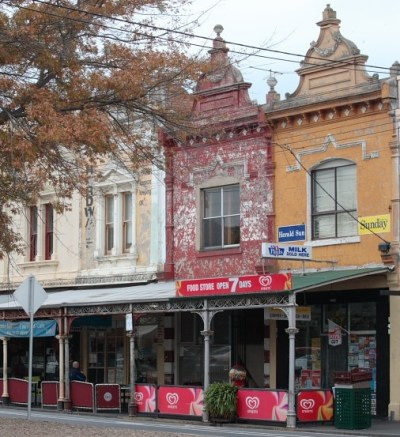
Photo: Rowan Crowe
378 Rathdowne Street North Carlton
|
378 Rathdowne Street North Carlton
The death of Terry O'Rourke in 2011, at the age of 90, marks the end of an era for this strip of shops, where no. 378 Rathdowne Street, today Rathdowne Deli, was a hardware store for more than eight decades.
The first shop on this site housed a bootmaker called Elston, who was here in 1889 and somewhere on this block for ten years before that.
He was succeeded by a Polish tailor, Gershon Redapple, then a costumiere and a fruiterer, but by 1906 the shop was Pearson's Ironmongery, run by proprietors Mac and Eva and later their son Percy for more than fifty years.
From the early 1960s Terry O'Rourke was recorded as also living at this address and in 1966 the shop became O'Rourke's Hardware, remaining so until the early 1990s.
Terry O'Rourke was very much a local, his family having lived across the road at no. 677 since 1941.
Interviewed in 1985 for a special commemorative edition of the City Alternative News, the O'Rourkes related a number of anecdotes from the early days of the business.
One item stocked by the Pearsons was seconds from Hoffman's Brunswick brick kiln. One customer for them was G.J. Coles, who loaded them into his motor bike with side car to resell in his Smith Street Nothing Over 2/6 shop.
Percy Pearson was a radio enthusiast and, when the first radios not requiring headphones became available, he mounted a loudspeaker outside the shop and relayed an Ashes match being played at Lords.
The crowd that gathered was big enough to hold up the cable trams and apparently the incident was reported in The Argus.
|
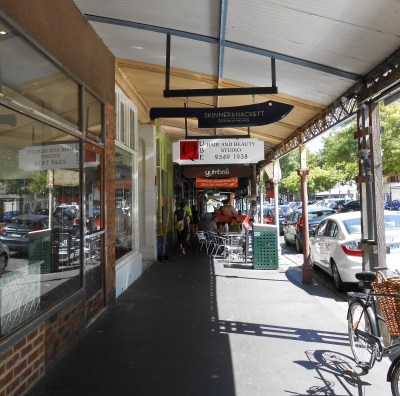
Photo: CCHG
400 Rathdowne Street North Carlton
|
400 Rathdowne Street North Carlton
400 Rathdowne Street, a few doors south of Fenwick Street on the eastern side and now home to Skinner & Hackett, has been a butcher's shop for the greater part of its life.
It is one of the few shops in this block to which there is no reference in Sands & McDougall's 1889 directory when street numbers were shown for the first time.
It was not built until 1893, one of three shops replacing two cottages, dating back to the 1870s, on the same and adjacent site.
The first recorded use is as a butcher's run by J.D. Varley in 1895 (he had been next door at no. 402 for two years before that) and by L. Muschella in 1896.
There are some very strange spellings in Sands & McDougall and this man is almost certainly Louis Muschialli, son of Domenico Muschialli who had a butcher's shop across the road from 1879 until 1887.
Louis himself ran a butcher's up near Pigdon Street from 1912 onwards.
Bastian Bros. took over the shop at no. 400 in 1898, after moving south from no. 512 and remained until 1924.
There was a butcher's shop at no. 400 until at least 1984 and Ron Warke had the shop for those last twenty years.
Signage on the rear brick wall advertises "Our Pride Smallgoods".
From the mid-1980s, the business changed hands to a hot bread shop, followed by Caffé Alleri.
Skinner & Hackett opened in November 2012, returning the building to its original function.
|
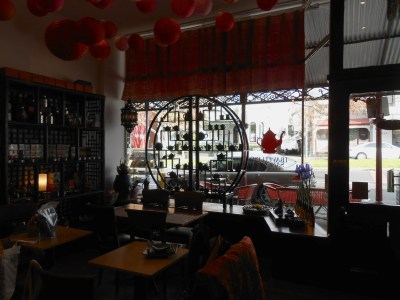
Photo: CCHG
The Travelling Samovar in 2013
412 Rathdowne Street North Carlton
References:
1 The Australian growers guide : Japanese green tea
2 Certificate of Title, Vol. 405, Fol. 810
3 Melbourne City Council Rate Books, Victoria Ward, 1871-1891
4 The Argus, 27 November 27, 1871, p. 1.
5 The Argus, 10 May 1873, p. 1
6 Fitzroy City Press, 6 September 1884, p. 3
7 Certificate of Title, Vol. 1739, Fol. 660
8 The Argus, 21 April 1886, p. 2
9 Notice of Intent, Reg. No. 4961, 12 May 1891 (VPRS 9288)
10 Melbourne City Council Rate Books, Victoria Ward, 1892
11 Building occupancy information sourced from Sands & McDougall and recollections of local residents.
12 The Sun, 9 May 1966, p. 1-2
13 Inquest Deposition File 1966/1387 (VPRS 24)
|
What does the delicately flavoured Japanese green tea "sencha" have in common with tobacco?
They have similar growing conditions in northeastern Victoria, where former tobacco growers are replacing their crops with fragrant tea bushes.
This Victorian-grown Japanese tea was sold at the Travelling Samovar, which operated from July 2013 to late 2016 on the site of a former tobacconist at 412 Rathdowne Street North Carlton.1
The land on which the three shops numbered 410 to 414 Rathdowne Street now stand was purchased by John Keane, produce merchant, in 1871.
For the next 20 years the Church (later Fenwick) Street corner site, measuring 54 x 80 feet, housed a collection of wood, brick and iron structures associated with Mr Keane's produce business.
Mr Keane may have had problems managing his livestock.
He placed advertisements in The Argus in 1871 and 1873 for recovery of a strayed pig and flock of geese, and in 1884 he was fined 10 shillings for allowing "a goat to wander in the public streets." 2,3,4,5,6
In the following year, 1885, ownership of the property was transferred to John's wife Bridget Frances Keane.
Mrs Keane owned several other properties in Rathdowne Street and elsewhere in Carlton, Richmond and Melbourne City, but they were heavily mortgaged and were advertised for sale by the Sheriff's Officer in 1886.
In May 1891, Mrs Keane lodged a Notice of Intent to build three two-storey shops, designed by architect Billing & Sons and built by T. Kilgariff.
In keeping with building practices at the time, construction of the three shops commenced soon after registration and was completed by 1892, when no. 414 was occupied by Mr Urquhart and nos. 410 and 412 were listed as "vacant" in the rate books. 7,8,9,10
W.C. Newington, a tobacconist, was the first occupant of no. 412 in 1893, and he was followed by a succession of tobacconists for the next 3 decades.
The longest serving tobacconist was Walter Large, who was there from 1901 to 1924, when he established a hairdressing business further north at no. 422 - now an optometrist's - where he remained until 1952.
His former shop then became a pastrycook/confectioner's.
It was Noonan's milk bar during World War 2 and Jack Ward, who lived as a child in Fenwick Street, remembered that the man had an artificial hand which he used to hold the cones for icecreams.
His sister Froney knew the same milk bar as McLeod's in the 1960s and used to play there with the daughter of the owners.11
Following closure of the milk bar, no. 412 was rented out for residential purposes.
In May 1966, the Stranger family suffered a tragic loss when one of their 3 year old twin boys died in a fire upstairs in the building.
By the end of that decade no. 412 is described as 'students', presumably in a bedsitter/houseshare arrangement.
From 1985 to 2006 this shop housed The Picture Box, whose rather striking logo was visible above the veranda.
More recent businesses include Dragon Noodle, the child-friendly café Teatime & Tales, and Jackson Café.12,13
The Travelling Samovar closed in late 2016 and the former tobacconist shop is entering the next phase of its history as Extension of Time, opened in February 2017.
The new café retained a link with the Travelling Samovar and had a small selection of Samovar teas available.
Extension of Time is now known as Fledgling.
|
The Pink Pills and the Grocer's Wife
425 Rathdowne Street Carlton
A grocery store in Carlton was the focus of a major advertising campaign for Dr Williams Pink Pills for Pale People in the late 19th century.
Described as "a neat and natty grocery store at the corner of Rathdown and Palmerston Streets", the business at 425 Rathdowne Street was operated by Thomas Scott Ross and his wife Margaret from 1899 to 1900.
In an investigation by the Carlton Gazette, Margaret spoke of how she suffered from neuralgia for years and experienced great relief after taking the patent medicine.
The Pink Pills, with active ingredients of iron oxide and magnesium sulphate, were claimed to "cure all diseases arising from a poor and watery condition of the blood".1,2
The grocery store was already well established when Mrs Ross and her husband took over the business, having operated at the site since 1875.
John Dyall was the first grocer (1875-1888), followed by Richards & Sons (1889-1894), C.A. Mayberry (1895) and C.J. Scott (1896-1898).
After Thomas Ross, Frank Morley ran the business from 1901 to 1904, then Mrs E.S. Bustard for one year and E.J. Chynoweth from 1906 to 1916.3
Then 425 Rathdowne Street had a change of function, with the arrival of Henry Lehrer, machinist (1917-1922), Mrs Sima Leykin,
white work manufacturer and costumier (1923-1933) and Isaac Chanen, clothing manufacturer (1934-1937).
The longest-serving occupant was Morie Oliver, bootmaker and repairer, from 1938 to 1969.
Mr Oliver was born Juda Mosiek Ilower in Poland in 1886 and he arrived in Australia in 1936.
He changed his name by deed poll in 1941 and was naturalised in 1942.4,5,6
The building and surrounding properties were demolished by 1970 to make way for the new Neill Street School, opened by the Minister for Education, Lindsay Thompson, in February 1973.
School children now play on the corner site where, over 100 years ago, Margaret Ross experienced her miraculous cure.7
References:
1 The West Australian, 11 January 1899, p.3
2 Directions for using Dr Williams Pink Pills for Pale People [Information brochure]
3 Sands & McDougall 1875-1916
4 Sands & McDougall 1917-1970
5 The Argus, 16 February 1942, p. 2
6 NAA:B6531 Naturalised/1939-1945/Oliver Morie (National Archives of Australia)
7 Carlton : a history, Melbourne University Press, 1904, p. 286
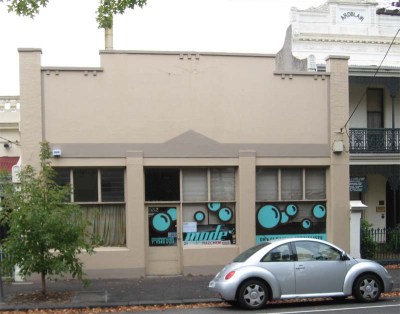
Photo: Julie Elder
520-522 Rathdowne Street North Carlton in 2011
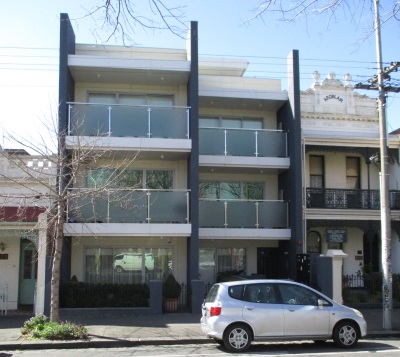
Photo: CCHG
520-522 Rathdowne Street North Carlton in 2017
|
520-522 Rathdowne Street North Carlton
A modern apartment complex, built in 2014, now stands on this site, but for more than ninety years the double block was home to a motor garage and dry cleaning business.
The original allotment, measuring 75 feet along the Rathdowne Street frontage, was first owned by William Clisby in 1871.
Clisby died in August 1880 and ownership of the land was transferred to William Ellingworth and George Sim, then sold to Sophia Gow in 1881.
Sophia's husband William was a builder and he used the vacant land as a builder's yard while he built the two-storey house "Ardblair" at no. 518.
This house was the Gow's family home for several years, then leased to Victoria Police as the North Carlton Police Station from 1893 until 1920, when the house and vacant land were subdivided and sold to different owners.
The vacant land had been used as an exercise yard and stabling for police horses.1
After decades as a repository for building materials and horse manure, 520-522 Rathdowne Street was to have its first major development.
In October 1920 the new owner, Martin John Shelley, lodged a building application for a garage to accommodate his expanding motor mechanic business.
The garage, completed in February 1921, occupied the full width of the Rathdowne Street frontage and had large wooden doors at the front and rear.
(The side door to the laneway off Richardson Street was not on the original plan and may have been added later.)
Shelley operated his business from the premises until 1941, when the building was converted for use as a drycleaner.
A new shopfront was added to receive customers and Pullers Dry Cleaners moved in to provide services for the remainder of the 20th century.
Mode Dry Cleaners took over the business and remained there until March 2011, following the sale of the property in 2010.2
In November 2013, the building which had stood there for more than ninety years was entirely demolished, making way for a four-level apartment building.
During demolition, signage harking back to the days of Martin Shelley's garage was uncovered as a reminder of the building's former function.
Notes and References:
1 Building ownership and occupancy information has been sourced from land title records and Melbourne City Council rate books.
2 Building application file and plans no. 2962, 1920 (VPRS 11200 and 11201).
Related items:
Development update
The Mechanic of Rathdowne Street : Martin John Shelley
|

Photo: CCHG
Paragon Café Signage
Corner of Rathdowne and Newry Streets North Carlton
Notes and References:
1 Walking along Rathdowne Street : 100 years of shopping, services and stories in North Carlton. CCHG, 2012. p. 60.
2 The Age, 10 February 1987, p. 32
3 The Age, 28 June, 2014
4 The Age, 11 May, 2015
|
651 Rathdowne Street North Carlton
After three decades in Rathdowne Street, North Carlton, the Paragon Café has served its last coffee.
The Paragon was not the first café to occupy the Rathdowne and Newry Streets corner site and, if history repeats itself, will not be the last.
The two-storey building at 651 Rathdowne Street dates back to 1892 and has served various business uses as a drapery, light manufacturer, milk bar and confectioner.
The café (or caffe) connection began in the 1960s, when black and white stripes appeared on the side wall to represent the Italian soccer team Juventus.
The Italian caffe of the 1960s became Tony's Espresso Bar from 1974, and the Paragon from November 1986. 1,2
The Paragon's recent history has been newsworthy, with two significant events in 2014 and 2015.
In June 2014, a stolen car driven by a drug-fuelled man mounted the footpath, travelled for a block along Rathdowne Street and crashed into the front of the Paragon.
Miraculously, no one was seriously injured, but several businesses suffered damage to stock and buildings.
The driver, who had mental health issues and prior convictions, was later sentenced to four years' jail.
Less than a year later, in May 2015, a fire broke out in the basement and the building suffered smoke and water damage.
The Paragon re-opened for business after repairs, but then closed for extensive renovations as an Italian restaurant, opened in 2016. 3,4
With the closure of the Paragon Café, the side wall has been painted over and North Carlton has lost the distinctive signage that once graced Newry Street.
|
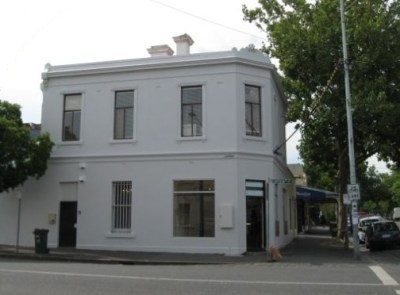
Photo: Julie Elder
693 Rathdowne Street North Carlton
|
693 Rathdowne Street North Carlton
A new patisserie, Depot de Pain, has opened on the corner of Curtain Street in a building which housed of one of the very first shops in this part of Rathdowne Street,
a butcher's started by Domenico Muschialli in 1879. The building was quite small - at that time there were three shops between Curtain Street and Birdsall Place whereas today there are only two.
The butcher's continued until 1886 and was followed first by doctor's rooms and then the North Carlton branch of the London Chartered Bank.
Bars on the window of what was once the strong room can still be seen from Curtain Street.
When Muschialli died in 1897 his widow Harriet opened a wine café here.
She ran the business until 1913 and then lived next door at no. 695 for most of the time until her death in 1923.
The wine café, or salon as it was sometimes described, had a succession of thirteen different owners before it closed in 1966.
At that time sweeping changes to the liquor licensing laws meant there was no longer a place for this kind of business.
Much of its wine had been sold to be consumed elsewhere - locals remember plonkos drinking in the park and schoolboys were known to avail themselves of takeaways.
Children entranced by stories of the American Wild West admired the wine café for its swinging doors.
In 1972 a travel agency opened on this site but, until the opening of Depot de Pain in 2011, no. 693 had not been in commercial use for some ten years,
largely because of planning regulations.
|
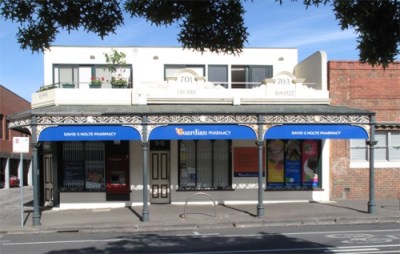
Photo: David Elder
701-703 Rathdowne Street North Carlton
|
701-703 Rathdowne Street North Carlton
Today Nolte's Pharmacy occupies a double site, no. 701-703, but these were separate shops until the 1940s.
Bootmaker Fittell began at no. 701 in 1896 before moving to no. 705 in 1897 and later across the street.
From 1897 to 1915 a saddler ran his business here. Like the shop next door it then housed a series of dealers.
In 1926 the last of them expanded into no. 699. What most long-term Carlton residents will remember about this site, however, is its history from 1931 as a cycle repair shop.
Harvey took over in 1946 and two years later expanded into no. 703.
Like many Carlton boys of that era, Jack and George Ward remember it vividly and speak of the red hose with brass fittings dispensing free air.
Pharmacist David Nolte moved his business here from the corner of Richardson Street in 1987, by which time, he says, the old bike shop was a rather spartan building.
No. 703 had been a fruiterer's, a furniture dealer's and a secondhand bookseller's before it was occupied from 1905 to 1914 by Corbet's house and land agency, the first of three Rathdowne Street sites this business was to occupy over a period of eight decades.
After Corbet moved north to the corner of Fenwick Street in 1915, no. 703 became a laundry, with Chinese owners from 1919 to 1948, when it became part of the cycle repair shop next door.
There were a number of laundries in Rathdowne Street in the early days, most lasting only a year or two, but this and another Chinese-run enterprise at no. 557, close to Princes Street, were by far the longest-lived of them.
|



















